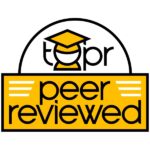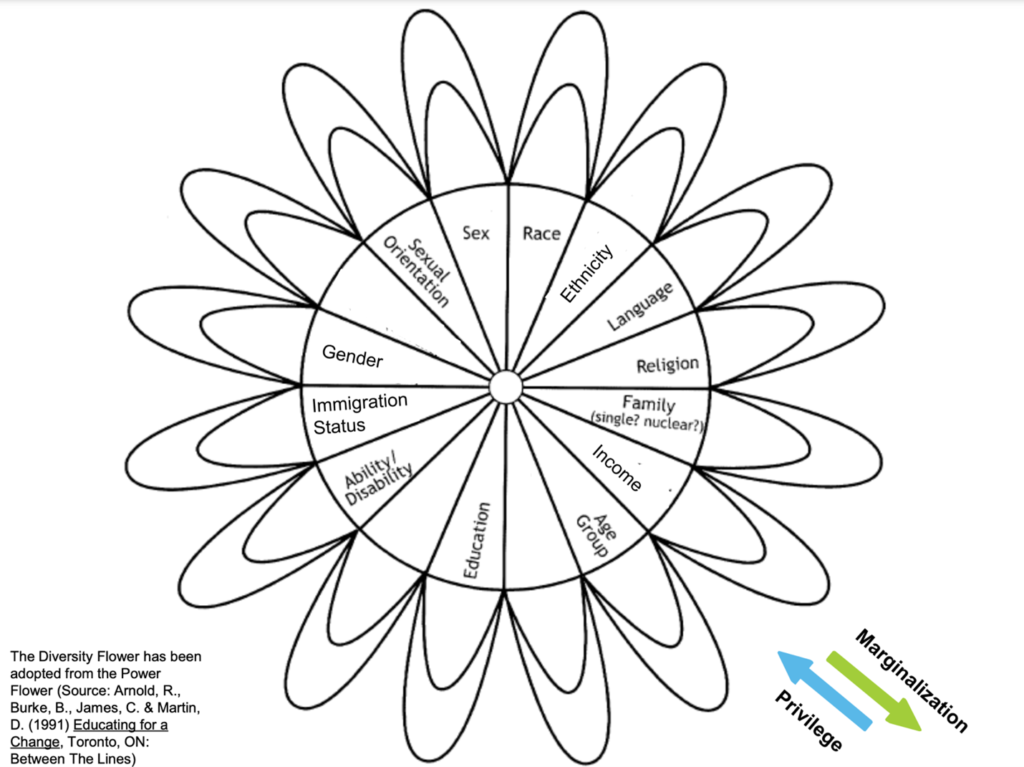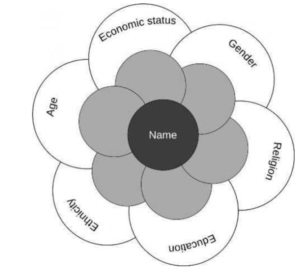
This strategy is designed to enhance students’ awareness of multiple intersecting identities that they have. It can be used for fostering inclusion and promote diversity in a classroom. It encourages students to accept others and work with others with respect.
Canadian educators in the field of social change created the “power flower” tool to help groups understand their social identity concerning those who hold power in our society (Rick et al., 1991, p. 87). The original design of this tool is like a daisy with 16 segments (see Figure 1), each representing a different aspect of our social identity. In the center, there is the name. There are two layers of petals, one inside and one outside. The outer petals represent the dominant identities in society. The inner petals include participants’ their own identity. The purpose of this exercise is to determine how similar or different each person’s social identity is from the dominant identity in their society. The more the inner petals match the outer ones, the more power that person holds.
Figure 1.

Strategy Implementation
While teaching her International Studies course at a Canadian university, Marwa Younes introduced The Power Flower: Inclusion and Diversity Activity. She did this because some students felt uncomfortable due to insensitive comments shared by some and tackling heated discussions in the class. Since the class had students from diverse backgrounds, Marwa believed it was a good idea to use the Power Flower activity. This activity helped students explore their own identities and become more aware of others’ identities. By reflecting on their own identity, it deepened their understanding of how some unintended comments can create exclusion on individuals, class, and society. This activity was used as online activity, yet it can be used in in person class. I followed the below steps:
Materials
Online Discussion Board
Process
- Describe how this exercise allows us to examine who we are in relation to others. Because we are both members of one class at the same time, we may be discriminated against and entitled to benefits at the same time. By reflecting on these aspects of our own lives, we can better understand ourselves and.
- Post the power flower on landscape paper as a discussion starter on the discussion board. Each petal represents a different aspect of our identity. When creating the flower, I chose seven categories of identity that I thought were most relevant to my context. I included gender, economic class, age, education, ethnicity, and religion. In the flower, the central part includes the name, the inner petals represent a person’s specific identity, and the outer petals represent the dominant group of that facet of identity (Figure 2).
- Ask each student to fill out their own categories, and then ask them to:
- List the number of personal characteristics that differ from their dominant identity.
- Mention if you can change any of these characteristics.
- Share any light bulb moments you had while filling the Power Flower.
- Present all the flowers together in one display and invite everyone to reflect on the following questions on the discussion board:
- How does the exercise reveal our group’s characteristics?
- Is there any difference or similarity between us?
- Share any light bulb moments when reading the power flower of others.
- Synthesize key ideas and share them with class.
Figure 2.

Reflections
Implementing The Power Flower: Inclusion and Diversity Activity in my International Studies course proved to be a valuable and enlightening experience. The benefits of this activity were multifold. Firstly, it created a safe space for students to explore and reflect on their own identities, fostering a deeper understanding of themselves and their peers. The structured nature of the exercise, with its clear categories like gender, economic class, age, education, ethnicity, and religion, facilitated a comprehensive exploration of various aspects of identity.
The online format of the activity allowed students to engage in thoughtful self-reflection and share their Power Flowers on the discussion board. This not only encouraged individual introspection but also promoted a collective understanding of the diverse identities within the class. The subsequent discussion and synthesis of key ideas brought forth meaningful insights into the group’s characteristics, highlighting both differences and similarities.
One notable benefit was the increased awareness of how seemingly innocuous comments could unintentionally exclude individuals based on their identities. The Power Flower acted as a powerful tool to unveil these dynamics, promoting empathy and sensitivity among students.
Challenges
However, like any pedagogical strategy, there were challenges, implementing The Power Flower: Inclusion and Diversity Activity posed some challenges:
- Some Students might resist engaging in discussions about personal identities due to discomfort, fear of judgment, or a lack of awareness. Encountering resistance requires a delicate approach to ensure a supportive and inclusive environment.
- The chosen categories might not fully capture the diversity of identities within the group. Some students may feel their identities are not adequately represented, leading to a potential sense of exclusion.
- The activity’s success depends heavily on effective facilitation. Ensuring a respectful and inclusive discussion, managing potential conflicts, and addressing sensitive topics require skilled facilitation that may be challenging for educators.
- Conducting the activity online may lead to challenges in ensuring active participation. Technical issues, varying levels of digital literacy, or reluctance to share personal information in an online forum may hinder the effectiveness of the activity.
- As for the applicability of this strategy, I believe The Power Flower: Inclusion and Diversity Activity is particularly well-suited for courses focused on social sciences, humanities, and cultural studies due to its emphasis on identity exploration and diversity awareness. However, the core concept of promoting inclusivity, empathy, and understanding of diverse perspectives can be adapted and incorporated into various disciplines. Here are some disciplines where similar strategies could be applied:
- Psychology: Activities that explore individual and collective identities can contribute to understanding human behavior, biases, and group dynamics.
- Sociology: The Power Flower aligns with sociological concepts related to identity, social stratification, and intersectionality, making it a natural fit for sociology courses.
- Ethics and Philosophy: Discussions about personal values, biases, and ethical considerations can be integrated into courses that explore ethical theories and philosophical perspectives.
- Cultural Studies: The activity is particularly relevant for courses focusing on cultural diversity, intercultural communication, and multiculturalism.
- Communication Studies: Understanding one’s identity and recognizing diverse perspectives are essential in communication contexts. The activity can enhance communication courses.
- Education: Educators can incorporate similar activities in teacher training programs to promote awareness of diverse student backgrounds and foster inclusive teaching practices.
- Human Resources Management: In a business context, similar activities can be beneficial for employees to understand their own biases and contribute to a more inclusive workplace.
While the categories may differ, the fundamental concept of exploring one’s identity and understanding the diverse identities within a group remains universal. It fosters a sense of inclusivity and empathy, making it a versatile tool for promoting understanding and collaboration in diverse educational settings.
Scholarly References
Arnold, R., Burke, B., James, C. & Martin, D. (1991). Educating for a Change, Toronto, ON: Between The Lines.
Citation
Younes, M. (2024). The Power Flower: An inclusion and diversity activity. In deNoyelles, A., Bauer, S., & Wyatt, S. (Eds), Teaching Online Pedagogical Repository. Orlando, FL: University of Central Florida Center for Distributed Learning.